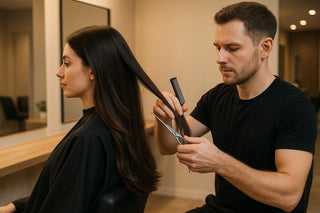The art of cutting long layers to achieve natural volume is a skill that requires precision, attention to detail, and a deep understanding of hairstyling techniques. In the video, an expert stylist shares invaluable tips and techniques designed to help professional barbers, hairstylists, and salon owners master the craft of creating long layers that enhance a client’s natural volume and overall look. This article distills the core insights from the video, offering a transformative guide to elevate your styling game.
The Essence of Long Layers: Precision and Client-Centered Styling
Creating long layers isn’t just about cutting hair; it’s about sculpting a style that complements the client’s face shape, hair type, and personal preferences. The video emphasizes two key principles:
- Understanding the Client’s Needs: The stylist underlines the importance of spending 10-20 minutes communicating with clients before starting. This ensures a mutual understanding of their expectations and lifestyle habits, which directly influence the haircut.
- Precision in Execution: Layering requires a strategic approach to maintain volume and balance. The stylist demonstrates how to cut methodically, focusing on both the technical aspects and the aesthetic outcome.
By following these principles, professionals can deliver a personalized hairstyle that meets - and exceeds - the client's expectations.
Step-by-Step Guide: Cutting Long Layers
Below is a structured breakdown of the techniques demonstrated in the video:
1. Preparation: Communication and Analysis
- Understand the client’s preferences: Begin by discussing their desired look, daily haircare routine, and any challenges they face with their current style.
- Analyze the hair: Assess the thickness, texture, and natural movement of the client’s hair. This is crucial for deciding how to layer without compromising volume.
2. Create the Base
- Section the hair: Divide the hair into manageable sections. Ensure clean partings and secure clips for precision.
- Determine the length: Establish the desired length for the longest layer, which will serve as the foundation of the style. Always communicate this decision with the client to avoid misunderstandings.
3. Strategic Layering: Building Natural Volume
- Focus on the critical areas: The stylist highlights the importance of the layers starting naturally from the crown and working toward the back. Avoid over-layering at the top, as this can make the hair appear thin.
- Lift and angle the hair: Use proper elevation techniques to ensure layers blend seamlessly. For clients with finer hair, lifting the hair higher while cutting helps maintain volume.
4. Detailing the Face-Framing Layers
- Refine the front sections: The stylist demonstrates how face-framing layers can transform the overall look. Careful attention is given to ensure these layers enhance the client’s facial features.
- Avoid extremes: Overly short front layers or drastic cuts can disrupt the balance. Always aim for a natural flow.
5. Final Adjustments and Blending
- Check the balance: After completing the cut, step back and assess the entire hairstyle. Ensure symmetry and smooth transitions between layers.
- Texturize for a polished finish: Use thinning shears or point-cutting techniques to soften harsh lines and add movement.
- Style the hair: Blow-dry the layers to reveal their natural volume and tweak any areas that need refinement.
Common Challenges and Solutions
The video addresses several challenges stylists may encounter when cutting long layers and provides actionable solutions:
- Hair Appears Thin After Layering: This often occurs when layers are cut too close to the scalp. To counteract this, elevate the hair higher during the cut and maintain a longer length for the top layers.
- Clients Dissatisfied with Length: Miscommunication about the desired length is a common issue. Always confirm the target length with the client before making the first cut.
- Uneven Layers: To ensure even layering, use consistent sectioning and cutting angles throughout the process. Regularly cross-check your work by combing through the layers.
Key Takeaways
Here are the most impactful insights from the video, condensed into actionable tips for professional stylists:
- Prioritize Communication: Spend time understanding your client’s needs and preferences before starting. This builds trust and ensures satisfaction.
- Layer Placement Matters: Ensure layers begin naturally from the crown and blend seamlessly toward the back.
- Preserve Volume: Avoid cutting layers too short or thinning out the top sections excessively.
- Face-Framing Layers Transform the Look: Subtle, well-placed layers around the face can enhance facial features and add elegance to the style.
- Precision Is Key: Use clean sectioning, consistent angles, and proper elevation to achieve balanced and polished layers.
- Adapt to Hair Type: Tailor your cutting techniques based on the client’s hair texture and thickness to achieve the best results.
- Refinement Is Essential: Blow-dry and style the hair after cutting to reveal the final look, making any necessary adjustments for perfection.
Conclusion
Mastering the art of cutting long layers is a crucial skill for any professional stylist looking to create versatile and flattering hairstyles. By combining precise techniques with a client-centered approach, as demonstrated in the video, you can achieve natural volume and beautifully layered cuts that leave a lasting impression. Whether you’re working with thick, thin, straight, or wavy hair, these techniques provide a roadmap to success.
The next time you approach a long-layered haircut, remember: it’s not just about the cut - it’s about the confidence and satisfaction you give your client. Strive for excellence, and let your craftsmanship speak for itself.
Source: "How to cut a Perfect Long Layered | Professional Long Layered Haircut The Ultimate Guide to Volume" - Love haircut, YouTube, Sep 4, 2025 - https://www.youtube.com/watch?v=0ImmcEyd8VE
Use: Embedded for reference. Brief quotes used for commentary/review.

